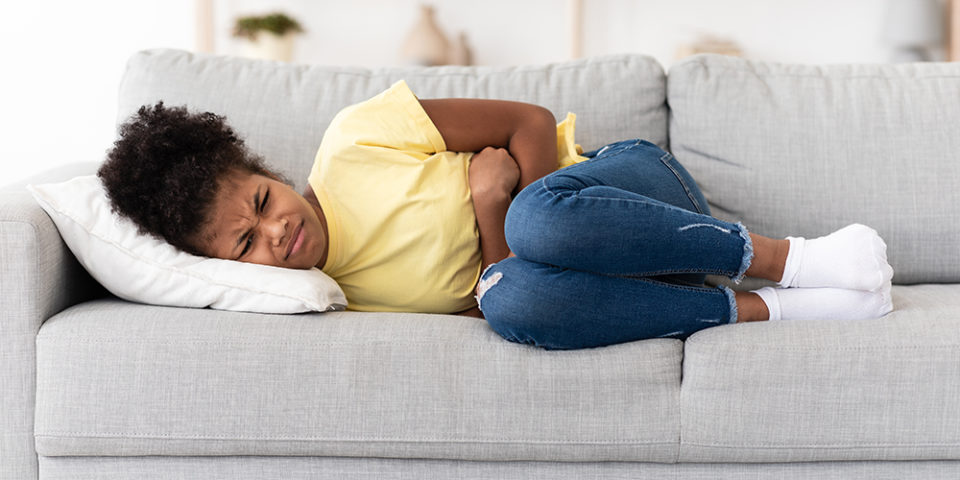What to do if your child has stomach pain
“My tummy hurts” is something every parent has heard, but it can be difficult to know what’s causing a young child’s discomfort and whether to seek medical care. Pediatric gastroenterologist Michael Dougherty, DO, offered tips on what to do when your child has stomach pain and how to know if it might be something more serious.
What might be causing a child’s stomach pain?
“Reasons your child has stomach pain are usually something simple like overeating, gas pains, or other types of indigestion,” Dr. Dougherty said. “Frequently a stomachache is caused by constipation. A stomachache also may be the first sign of stomach flu (viral gastroenteritis) and vomiting or diarrhea will soon follow.”
Food poisoning or a urinary tract infection (UTI) can stomach pains as well. Most stomachaches resolve on their own.
A common serious cause is appendicitis.
Stomachaches that keep coming back (recurrent) can have many causes. The most common causes of frequent stomachaches in kids are stress and worries.
“Over 10% of children have recurrent stomachaches from stress” Dr. Dougherty said. “The pain is mild but real and occurs in the pit of the stomach or near the belly button. If your child keeps getting stomachaches, talk to your doctor.”
How long does a stomachache typically last?
With harmless causes, the pain is usually better or gone in a few hours. With stomach flu, the stomach may hurt before each bout of vomiting or diarrhea. With serious causes, the pain worsens or becomes constant. Other worrisome signs include bloody diarrhea, weight loss and pain awaking a child from sleep.
What can I do to help when my child has stomach pain?
“First, do not give any medicines for stomach cramps unless you have talked with your healthcare provider. Especially avoid painkillers,” Dr. Dougherty said.
If you suspect your child has stomach pain from eating or illness, use the following guidelines for treatment:
- Rest. Your child should lie down and rest until they feel better. A warm washcloth or heating pad on the stomach for 20 minutes may speed recovery.
- Diet. Avoid giving your child solid foods. Only allow sips of clear fluids. Keep a vomiting pan handy. Younger children are especially likely to refer to nausea as “a stomachache.”
- Sitting on the toilet. Encourage your child to sit on the toilet and try to pass a bowel movement. This may relieve pain if it is due to constipation or diarrhea.
How do I know if my child has appendicitis?
Appendicitis mostly affects kids and teens between 5 and 20 years old. It is rare in infants. The first signs of appendicitis are often a mild fever and pain around the belly button.
“It might seem like just a stomachache, but with appendicitis, the pain usually gets worse and moves to the lower right side of the belly,” Dr. Dougherty said.
If your child has belly pain, be on the lookout for these signs of appendicitis:
- Strong pain, mainly around the belly button or in the lower right part of the belly
- Child typically does not want to move or be touched
- Low-grade fever
- Loss of appetite
- Nausea (feeling sick) and vomiting (throwing up)
Call your doctor immediately if you think your child has appendicitis.
What can I do if stress is causing my child’s stomach pain?
If your child has already seen a doctor and you know that the stomachaches are from stress or worry, these suggestions might ease the pain:
- Help your child worry less. Children who often have stomachaches tend to be sensitive, serious and conscientious children. This can make them more vulnerable to the normal stresses of life, such as changing schools or moving. Help your child talk about events that trigger their pains and how they are going to cope with them.
- Make sure your child doesn’t miss any school because of stomachaches. Stressed children tend to want to stay home when the going gets rough, but it is not helpful to keep kids at home in that case.
- Teach your child to use relaxation exercises for pain. Have them lie down in a quiet place, take deep, slow breaths and think about something pleasant. Blowing soap bubbles is helpful for deep breathing, as well as listening to audio that teaches relaxation. Sometimes it is beneficial to use cognitive behavioral therapy (CBT) with the help from a professional psychotherapist. Additionally, physical activity such as Yoga has been shown to be beneficial.
Find the care you need, close to home
Our primary care physicians provide well visits and everyday care when you need it with compassion and expertise.
Find Primary Care Near You

